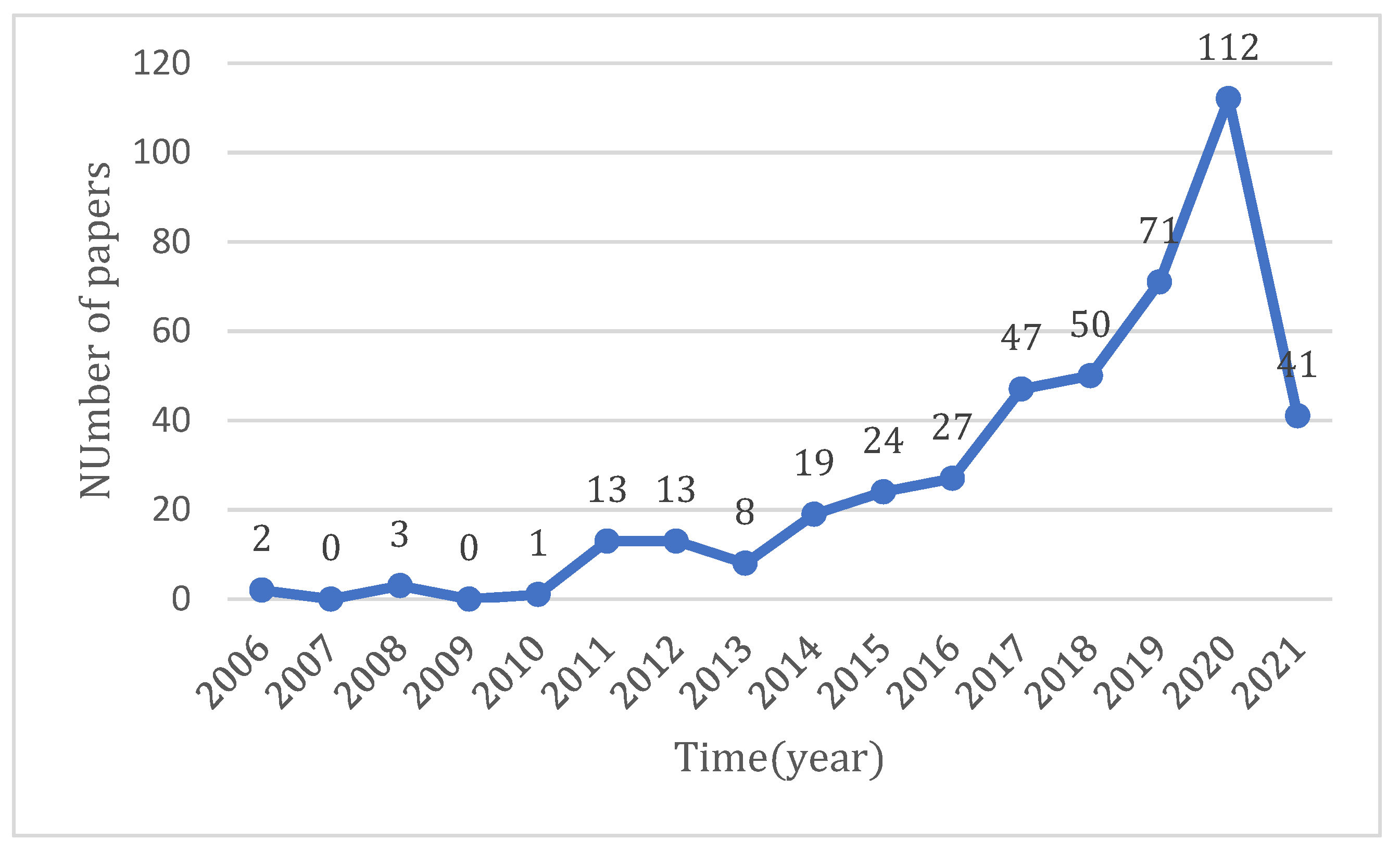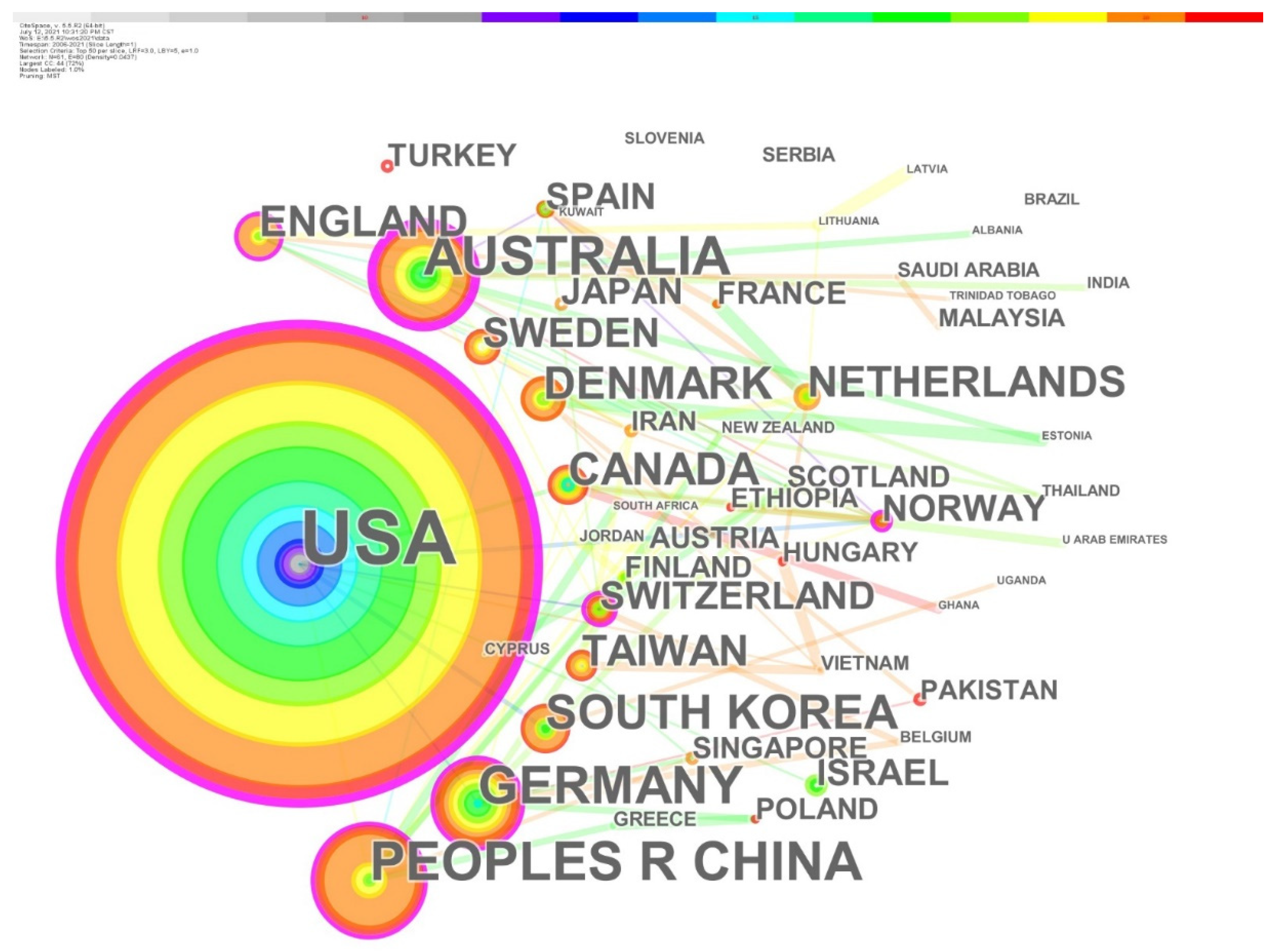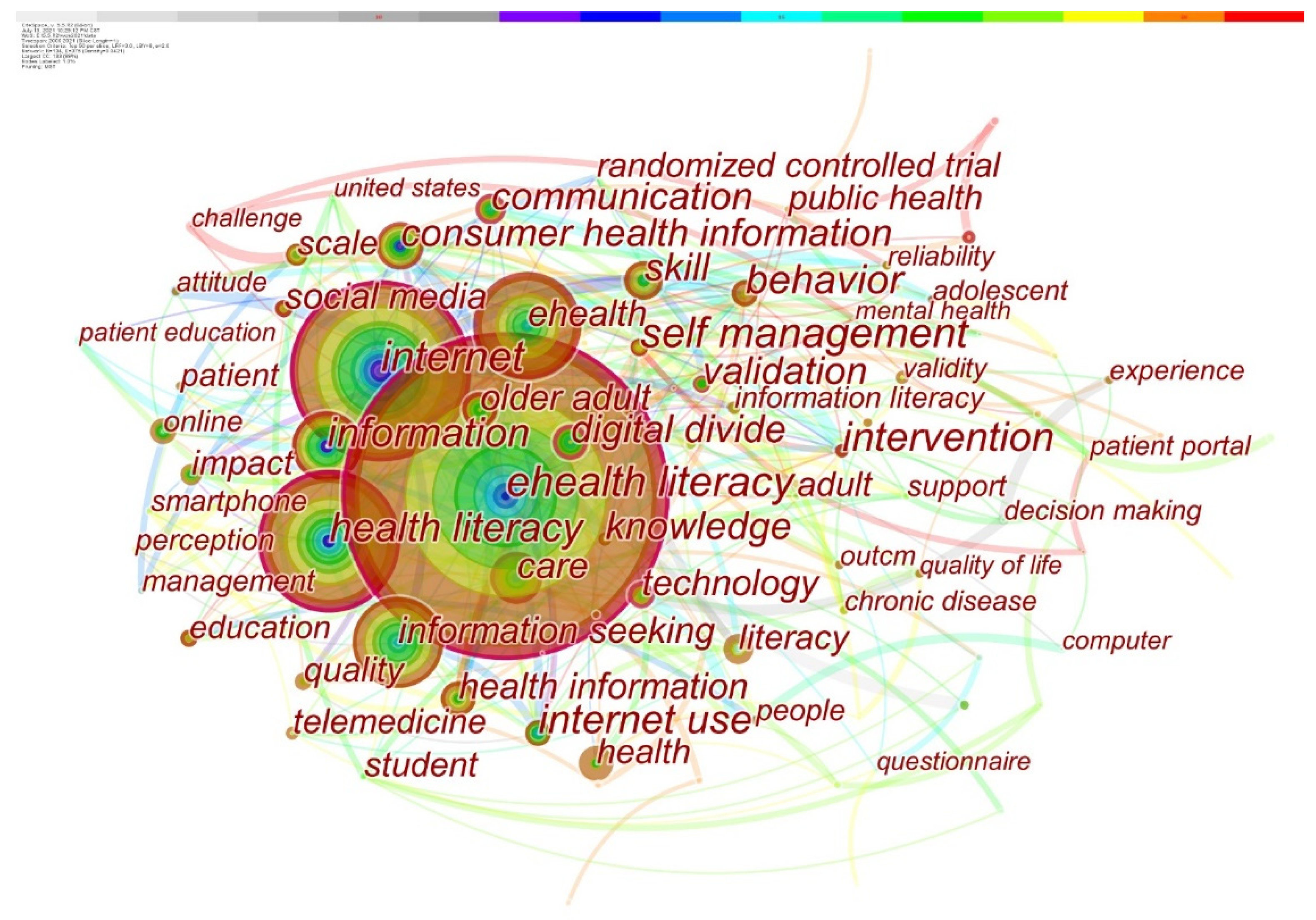As seen from keyword clustering and thematic evolution, the research on ehealth literacy involves multiple subjects such as the elderly, college students, and patients with different diseases; analyzes a variety of health behaviors such as self-management, quality of life, and physical activity, as well as the digital divide caused by factors such as age and education; and develops relevant tools, as well as promoting ehealth through technology, social media, etc. Therefore, based on the co-word network of keywords, co-word timeline view, high-frequency keyword statistics, clustering, and thematic evolution path, and combined with the content of classical literature, this paper summarizes the ehealth literacy research into four topics: the evaluation of e-health literacy, the correlation between e-health literacy and health-promotion behaviors, influencing factors of e-health literacy, and interventions to improve e-health literacy.
4.1. Research on E-Health Literacy Evaluation
An essential foundation for studying public e-health literacy is a scientific evaluation of e-health literacy among different demographics, which sets the groundwork for comprehending the current situation and devising intervention strategies. As indicated in
Table 3, academics have created a variety of assessment tools to assess e-health literacy. There are differences in the relevant assessment models of these tools and their application scenarios, applicable groups, evaluation topics, evaluation dimensions, etc.
The eHEALS scale, developed by Norman, is the first self-assessment tool for evaluating e-health literacy. With a total of eight items, the scale attempts to assess six core competencies of e-health literacy, using a five-point Likert rating system to score each item. The higher the score, the better the e-health literacy [
9]. The eHEALS scale is one of the most extensively used instruments to evaluate e-health literacy. Several new e-health literacy scales have been created based on this research. The e-HLS (e-health literacy scale) instrument, constructed by Seckin G, has 19 items, including three dimensions of communication, trust, and action [
18]; the Digital Health Literacy Instrument (DHLI) devised by Vaart RVD et al. has 21 self-assessment projects and 7 performance-based items that require respondents to apply e-health literacy to answer objective questions [
19]. The eHealth Literacy Assessment Toolkit (eHLA), created by Farnoe A et al., contains four health literacy assessment tools and three digital literacy assessment tools [
20].
Additionally, several researchers built assessment tools based on the self-developed concept and framework of e-health literacy. Jean BS and others produced the DHLAT (Digital Health Literacy Assessment Tool), a story-based tool for evaluating adolescent e-health literacy [
21]. In the hypothetical environment, students individually answer a series of questions to assist a peer in using the Internet to find information about the disease (type 1 diabetes) with which she has recently been diagnosed. Norgaard O. et al. developed the eHealth Literacy Framework (eHLF), which encompasses individual knowledge and skills, systems, and interactions between individuals and systems [
22]. Built on eHLF, Kayser L et al. designed an eHLQ (eHealth Literacy Questionnaire) with 35 items in 7 categories, which adds the two components of personal experience and interaction with systems, providing a broader dimension of e-health literacy [
23]. Paige SR et al. proposed the transactional model of eHealth literacy (TMeHL), emphasizing communicative features and focusing on individual abilities to interact and exchange information with others while solving health concerns [
24]. They generated the Transactional eHealth Literacy Instrument (TeHLI) to assess perceptual abilities associated with the capacity to comprehend, discuss, evaluate, and utilize online health information [
25].
Aside from designing assessment tools, eHEALS is frequently utilized since it can test e-health literacy with a brief questionnaire. However, the scale is built based on the context of Britain and America, and only an English version available, so it has to be tested to see if it is also valid in other linguistic situations. As a consequence, researchers from around the world have translated eHEALS into nearly twenty languages for testing and evaluation, including Dutch [
26], Japanese [
27], German [
28], Portuguese [
29], Spanish [
30], Turkish [
31], Italian [
32], Korean [
33], Hungarian [
34], Serbian [
35], Polish [
36], Chinese [
37], Greek [
38], Norwegian [
39], Amharic [
40], Swedish [
41], Arabic [
42], and Indonesian [
43]. The findings indicated that the translated versions have high internal consistency and credibility.
4.2. Research on the Correlation between E-Health Literacy and Health-Promotion Behaviors
Health-promoting behaviors include health responsibility, stress management, exercise behavior, dietary behavior, self-realization, and social support, all of which are positive activities or concepts that are beneficial to preserve or promote health [
44]. They can assist individuals in avoiding disease, enhancing health, increasing quality of life, and maintaining excellent physical and mental health. Due to the widespread use of the Internet and mobile devices, most people have access to health-related information on the Internet. Individuals with varying levels of e-health literacy range in their ability to seek, comprehend, evaluate, and use online health information, as well as solve health-related problems. Understanding the importance of e-health literacy on health behaviors will equip professionals with the knowledge to enhance population health intervention, increase e-health literacy, and encourage healthy behaviors. Therefore, academics have begun to focus on the link between e-health literacy and health behaviors.
Table 4 shows that the level of e-health literacy is a key factor in improving health behaviors.
Health responsibility refers to paying attention to and being accountable for one’s health. Studies have shown that individuals with greater levels of e-health literacy are linked to regular online searches for health information [
45], as well as greater frequency of web-based health-seeking actions [
46]. Individuals with better e-health literacy can acquire more accurate health-related information, evaluate the quality of information more properly, have better self-management capacity, connect with healthcare practitioners more effectively, and engage in treatment and nursing decision-making [
47,
48]. Furthermore, in the case of the COVID-19 pandemic, the higher the level of e-health literacy, the greater the willingness to receive vaccination and the better the compliance with public health guidelines [
49].
Stress management is the ability to cope with stress. Mental health benefits significantly from e-health literacy. People with e-health literacy can better analyze and alter their health state, avoid negative feelings such as fear and distrust, and enhance their mental health [
10]. Individuals with greater levels of e-health literacy are more equipped to cope with challenges, which means they are less likely to suffer from sleeplessness or psychological anguish [
50]. Moreover, since the outbreak of COVID-19, a great amount of incorrect and misleading information has been spreading, causing people to be confused and fearful [
51]. Individuals with high e-health literacy can better obtain accurate information and manage negative emotions and symptoms, minimizing the epidemic’s frequent mental health issues (such as depression, sleeplessness, and posttraumatic stress disorder) [
52].
Nutrition relates to a person’s eating habits and food choices. Healthy food consumption is adversely connected with e-health literacy, but a balanced diet and regular eating habits are favorably correlated [
53]. Individuals with better e-health literacy are more likely to adopt healthy eating behaviors (for example, consuming low-fat meals, low-sugar cereals, vegetables, and fruits) [
54] because they can more properly search for and interpret information about healthy eating on the Internet [
55].
Exercise refers to the regular undertaking of exercise. E-health literacy can positively predict exercise [
54]. Individuals with greater literacy are more likely to exercise frequently and participate in sports [
55,
56] (for example, exercise at least three times a week [
57]). Furthermore, an emerging online fitness culture (including health, exercise, and fitness groups or blogs on various social networking sites) disseminates pertinent health and fitness information through online social interaction to inspire and motivate people to live a healthy life. Users of online fitness who have a high level of e-health literacy may better recognize the beneficial information in a large number of mixed materials and modify their lifestyles through appropriate activities [
58].
Self-actualization implies the attitude and expectations of life. The link between e-health literacy and quality of life is clear and favorable [
59]. Individuals with a high level of e-health literacy may actively create their internal resources to accomplish spiritual growth, giving them a strong feeling of purpose and optimism for the future [
60].
Social support describes closeness and intimacy with others. Individuals with high e-health literacy are more likely to be able to solve interpersonal difficulties and sustain meaningful connections with others [
60]. At the same time, they may make greater use of interpersonal resources and achieve better results in social relationships [
15].
4.3. Research on Influencing Factors of E-Health Literacy
With the rapid development of the Internet and the increase in health information from various online sources, investigating the population’s level of e-health literacy and analyzing its influencing factors can help to formulate intervention measures to improve the population’s e-health literacy. Researchers used questionnaires and interviews to gather and evaluate data, and they discovered that the population’s degree of e-health literacy was influenced by a variety of factors, as shown in
Table 5.
First, age is associated with e-health literacy. The younger the age, the greater the level of e-health literacy [
61]. In terms of gender, women are more likely than men to seek health information on the Internet [
62]; as for education, a higher education level is associated with higher e-health literacy [
63]; in terms of the aspect of income, people with lower incomes have lower e-health literacy [
64]; and as for residential area, the utility of online medical resources in rural populations is lower than that in urban populations [
65]. People with good health perceptions are more likely to have e-health literacy, possibly because they are more inclined to seek medical resources before their health deteriorates [
66]; additionally, because medical students are more exposed to medical health information in their courses of study, their electronic literacy level is higher than that of other majors [
67].
Second, research indicated that a favorable attitude toward the use of online resources is associated with better levels of e-health literacy [
66]. Recognizing the utility of receiving health information via the Internet and the significance of making health decisions utilizing Internet resources is another crucial component correlated to e-health literacy [
68].
Finally, the motive is the internal driving force that triggers certain behaviors. Individual health awareness, as one of the reasons, has a direct influence on the use of Internet health resources; for example, those who engage in physical activity seem to be more prone to have e-health literacy [
11]. Furthermore, confidence in the use and evaluation of network resources will influence e-health literacy. The amount of information literacy [
11], frequency of Internet use [
69], and network competency [
70] are all essential parts of e-health literacy.
4.4. Research on Intervention Measures for Improving E-Health Literacy
With the widespread use of information and communication technology in the medical profession, numerous medical and health institutions and organizations are progressively posting health information on the Internet, and the Internet has become an essential source of high-quality health information. However, Internet resources can only contribute if the public has adequate e-health literacy and avoids low-quality materials that are harmful to health. According to research, the amount of e-health literacy is the best predictor of individual health behavior [
71]. As a result, researchers began to focus on the design and implementation of intervention measures to foster and promote e-health literacy.
Table 6 shows the most often utilized intervention approaches to increase e-health literacy at the moment.
Participants accessing high-quality professional health information websites, using, querying, and learning credible health information offered by websites, and contacting relevant professionals are examples of interventions employing professional health websites. To avoid poor information on the website disrupting the learning effect of participants, high-quality websites sponsored by the government and hospitals were deployed. The results of a study on the effects of the use of professional health websites by diverse groups of teenagers with epilepsy and their parents [
72], patients with heart disease [
73], the elderly [
74], and informal caregivers [
75] revealed that participants’ e-health literacy had improved, and they had a positive attitude about the use of websites to impact their health. Furthermore, in addition to providing trustworthy information, aspects such as easy access, user-friendliness, and simple language [
76] contributed to e-health literacy education.
Participants in training programs were guided in the process of searching, examining, and assessing electronic health information. Participating in massive open online courses (MOOCs) [
77], viewing instructional films [
78,
79], reading text and graphic materials [
80], and taking associated quizzes [
81] were all practices of training, and learning techniques included autonomous learning, collaborative learning [
82], and discussion learning [
83]. Following the completion of the training project, participants’ e-health literacy, ability to search for health information online, knowledge of network health information, and ability to evaluate network information were greatly enhanced. It can be observed that conducting targeted e-health literacy training programs in the population effectively increases public e-health literacy.
Mobile health care apps can provide appropriate information and interventions based on users’ needs economically and efficiently and promote interaction and communication between app providers and users, allowing users to better understand medical information and monitor and manage their health status. Similarly, wearable medical devices can assist users in understanding and evaluating health information from other sources based on their personal experience by collecting and providing feedback on relevant data and resources, leading to subsequent electronic health behaviors. Competent medical health mobile terminals may provide enough health education, hence increasing the population’s e-health literacy.
Mobile health care apps can provide appropriate information and intervention based on users’ needs, in an economical and efficient manner, and promote interaction and communication between app providers and users, allowing users to better understand medical information and monitor and manage their health status [
84,
85]. Similarly, wearable medical devices can assist users in understanding and evaluating health information from other sources based on their personal experience by collecting and providing relevant data and resources, leading to subsequent electronic health behaviors [
86]. Effective medical health mobile terminals can provide adequate health education, hence enhancing public e-health literacy.
Meanwhile, during the recent coronavirus epidemic, with correct information, disinformation, and changing recommendations blended in a massive amount of materials, there was a tremendous need for instructions on how to identify trustworthy health information among them. As a result, the engagement of people with higher e-health literacy in guiding people with lower e-health literacy, such as college students assisting the elderly [
87] and volunteer doctors providing the most up-to-date epidemic-related information to the general population [
88], can help improve e-health literacy and narrow the digital divide.










